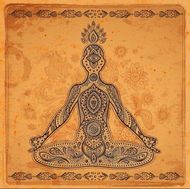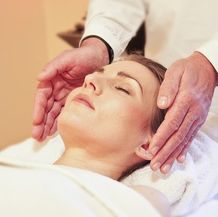 Yoga Nidra means “yogic sleep” in the Sanskrit language, the original language of yoga. This isn’t the same thing as “shavasana”, the resting pose done at the end of most yoga classes but Yoga Nidra is often practiced in that pose. Yoga Nidra is a guided meditation practice often attributed to the Tantric tradition in India (Tantra being a philosophical tradition that emerged from the older Samkhya system that counts Ayurveda and Yoga as branches) and developed in modern times by the Bihar School of Yoga in India and refined and secularized by Richard Miller, PhD as the iRest (Integrative Restoration) method that has been scientifically studied for its effects on the recovering military population at Walter Reed Army Medical Hospital in Bethesda MD. Participants may practice lying down (with props for comfort if necessary and available) or sitting and are given time to settle into position and steady the breath before being directed to focus the mind on various things such as a specific part of the body (left big toe, right thumb, etc) or on principles of opposites (happiness, sadness; hot, cold). Some methods ask that focus be switched rapidly from one thing to the next, others allow for time to notice sensations as they arise while directly the observer to remain the observer and avoid attaching the mind to the sensations. The iRest method in particular delineates ten stages of practice from setting an intention to creating an inner resource or safe space within to draw on when or if difficulty arises with a particular direction, all the way to learning how to see and accept life as it is without judgement, a very powerful tool for reducing the effects of stressful situations. You are not supposed to fall asleep during Yoga Nidra but sometimes it happens due to excessive fatigue; not to worry, though the conscious mind may clock out for a time the subconscious mind still receives the vibrations of the directions spoken and the body still gains the benefits! This make it a wonderful addition to any exercise program; rest days are needed to recover from work or intense exercise routines and adding a directed healing meditation to a rest day supercharges the body’s ability to recover and rejuvenate itself. Even if you feel no bodily fatigue or stress Yoga Nidra is beneficial for sharpening the mind’s ability to focus and concentrate. There are no complicated skills to master, no strength or flexibility required to participate, ANYONE in ANY CONDITION fit or frail can benefit from Yoga Nidra! To sign up for the Yoga Nidra Reiki workshop with me and Phila Hoopes on Saturday May 5 from 4 - 6 pm (save by signing up ahead of time!) please visit https://www.eventbee.com/v/relaxrenewreplenishyoganidra-reiki#/tickets
1 Comment
 By Phila Hoopes The word Reiki combines two Japanese words - Rei, meaning "God's Wisdom or the Higher Power" and Ki, meaning "life force energy". So you can define Reiki as "spiritually guided life force energy." Reiki is a Japanese healing technique by which this energy is transmitted through the laying on of hands to support relaxation and relief from stress, pain, and illness in the mind, body or spirit, and promote healing. So, you may say, we’re looking at some serious “woo” here, right? Actually – while practitioners may take a wide range of approaches, some more “woo-woo” than others, traditional Usui Reiki is gaining genuine recognition in the world of conventional medicine. While mainstream science hasn’t yet identified how it works, the National Center for Complementary & Alternative Medicine (NCCAM) of the National Institutes of Health (NIH) classifies Reiki as a form of biofield therapy. Researcher Pamela Miles teaches that Reiki affects the vibrational body, gently supporting its natural self-healing mechanisms by fostering balance.* In the 95 years since Mikao Usui established the practice of Reiki, practitioners have found that it may be used effectively for anyone, human or nonhuman, in person or remotely. It supports all other medical or alternative approaches to relieve symptoms and side effects and promote recovery. Because it involves no physical manipulation, nor the ingestion or application of any drugs, creams, or oils, it has no known contraindications. It’s impossible to be allergic to Reiki! For all of these reasons, Reiki is used as a supplement to conventional and integrative care in 76 hospitals in the U.S. and abroad, treating a wide range of conditions including:
So, you may ask – what does Reiki feel like? Well, you remain clothed, and you may be sitting or lying down. The practitioner may gently place hands on your body – or may hold hands a few inches above your body – in a series of locations roughly corresponding to the chakras. You may feel warmth, heat, or tingling in those areas, and most people report feeling a sense of relaxation that deepens as the session progresses. A session may be as short as 15 minutes or as long as 90. Afterward, you may feel sleepy – or energized! It’s common to experience shifts, whether physical, psychological or emotional: if you have been blocked in some way (whether it’s, say, constipation, a charley-horse, or blocked emotions), you may experience a release. To integrate your Reiki experience and energy release, be gentle to yourself! Drink plenty of water, get plenty of sleep (and pay attention to your dreams!). Observe your experience with love and acceptance, remembering that this is energy moving. If you experience a major psychological or emotional release, stay in contact with your therapist to process the thoughts and feelings. And if you have any questions, please contact me at phila@allrelationsreiki.com. I look forward to seeing you! _____________________________________________ * Pamela Miles, Reiki: A Comprehensive Guide (New York: Penguin, 2008), 8 |
Proudly powered by Weebly


 RSS Feed
RSS Feed